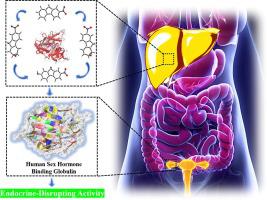Environment International ( IF 10.3 ) Pub Date : 2022-06-16 , DOI: 10.1016/j.envint.2022.107355 Junhua Zhou 1 , Xin Zhang 1 , Yanwei Li 2 , Shanshan Feng 2 , Qingzhu Zhang 2 , Wenxing Wang 2

|
Nitropolycyclic aromatic hydrocarbons (NPAHs) present one of the most important airborne pollutants. Recent studies have shown that one of the most abundant NPAHs, 2-Nitrofluorene (NF), was supposed to be converted to endocrine-disrupting metabolites by cytochrome P450 1A1 (CYP1A1) in human cells. However, the mechanism is still largely unexplored. Here the metabolic activation and transformation mechanism of NF catalyzed by CYP1A1 were systematically studied with the aid of Molecular Dynamics, Density Functional Theory and Quantum Mechanics/Molecular Mechanics techniques. We evidence that CYP1A1 can activate NF through two elementary processes: (i) electrophilic addition (12.4 kcal·mol−1) or hydrogen abstraction (38.2 kcal·mol−1) and (ii) epoxidation (5.9 and 8.7 kcal·mol−1) or NIH shift (12.5 and 14.9 kcal·mol−1) or proton shuttle (12.1 kcal·mol−1). Electrophilic addition was found to be the rate-determining step while epoxidation rather than NIH shift or proton shuttle is the more feasible pathway after electrophilic addition. Metabolites 6,7-epoxide-2-nitrofluorene and 7,8-epoxide-2-nitrofluorene were identified as the major epoxidation products. Epoxides are unstable and easy to react with hydrated hydrogen ions and hydroxyls to produce endocrine disrupter 7-hydroxy-2-nitrofluorene. Toxic analysis shows that some of the metabolites are more toxic to model aquatic organisms (e.g. Green algea) than NF. Binding affinity analysis to human sex hormone binding globulin reveals that NF metabolites all have endocrine-disrupting potential. This study provides a comprehensive understanding on the biotransformation process of NF and may aid future studies on various NPAHs activation catalyzed by human P450 enzyme.
中文翻译:

人细胞色素 P450 1A1 催化的 2-硝基芴的内分泌干扰代谢激活:QM/MM 方法
硝基多环芳烃 (NPAH) 是最重要的空气污染物之一。最近的研究表明,最丰富的 NPAH 之一 2-硝基芴 (NF) 可能会被人体细胞中的细胞色素 P450 1A1 (CYP1A1) 转化为内分泌干扰代谢物。然而,该机制在很大程度上仍未被探索。借助分子动力学、密度泛函理论和量子力学/分子力学技术,系统研究了CYP1A1催化NF的代谢活化和转化机制。我们证明CYP1A1可以通过两个基本过程激活NF:(i)亲电加成(12.4 kcal·mol −1)或夺氢(38.2 kcal·mol −1)和(ii)环氧化(5.9和8.7 kcal·mol −1 ))或NIH位移(12.5和14.9 kcal·mol -1)或质子穿梭(12.1 kcal·mol -1)。发现亲电加成是速率决定步骤,而环氧化而不是 NIH 位移或质子穿梭是亲电加成后更可行的途径。代谢物 6,7-环氧化物-2-硝基芴和 7,8-环氧化物-2-硝基芴被确定为主要环氧化产物。环氧化物不稳定,容易与水合氢离子和羟基反应,生成内分泌干扰物7-羟基-2-硝基芴。毒性分析表明,某些代谢物对模型水生生物(例如绿藻)的毒性比 NF 更大。对人性激素结合球蛋白的结合亲和力分析表明,NF 代谢物均具有内分泌干扰潜力。这项研究提供了对NF生物转化过程的全面了解,并可能有助于未来研究人类P450酶催化的各种NPAHs激活。






























 京公网安备 11010802027423号
京公网安备 11010802027423号